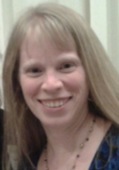The “Right” Formula?
by Connie Rivera
I was a participant in a training recently where we were given the tools to “discover” one of the not-as-common formulas provided on the Formula Sheet for the Hi-SET test. After some exploration experiences, we were asked to write an equation that showed the relationship between the variables that could be used to find the area of any such shape. Many of the other teachers already knew the formula and were able to link together the ideas to explain how to get the most common representation of the formula (the one on the Formula Sheet). Because I did not know the formula, the formula I created represented what I saw as I worked through patterns and constants in an example problem. My version made me feel accomplished and like I had a deeper understanding. It made sense to me and I could explain how to get there, making a composite of more common shapes. However, when the others at my table saw such an unusual equation, the general reaction was, “That can’t be right!” My tablemates spent some time re-arranging my equation and learned that it did actually work. It sparked a conversation about the “right formula” and there was a sense at the table that I hadn’t really gotten the answer right.
As someone who struggled through math the first time around, and who was told to follow a formula that I couldn’t “see,” I now think, “Why?” What do we accomplish by insisting that all students do things the same way? I think that permission to see math flexibly is part of what freed me from some of the anxiety that math still brings all these years into studying it. If one student sees the perimeter of a rectangle as l + l + w + w, another (L+W) + (L+W), and someone else sees 2x +2y, as long as they can explain the meaning, recognize it in other forms, and know how to use the formula to find perimeter or a side when the perimeter is known, does it really matter? When a student creates a formula, they “own” it and connect to it. It has meaning. To be honest, I still can’t “see” the formula on the Hi-SET Formula Sheet and so I still can’t tell you that formula without looking it up. It doesn’t make sense to me that way. However, I can still re-create the formula I created and find the area of that shape even though the session was over a month ago. So, not only is this the way it made sense to me, but it was something I retained because I connected to it.
When I attended college, I planned my schedule to avoid math. It wasn’t until I was a GED Prep teacher that I started facing it again. Because I knew it was my weakness, I attended a math PD session and it ended up changing my life. It opened my eyes to the way it can feel to receive math instruction. I hope my engineer father never finds this blog, but I can tell you that being told tricks to memorize a formula that didn’t make sense to me (like “Cornbread are round, pi R squared!”) feels very different than being guided through a sequence of math experiences and being asked generative questions to draw a formula or a solution out of me. I do not feel the same sense of accomplishment and deepened understanding when using traditional formulas like those on the Formula Sheet to “plug and chug” – substituting numbers from a word problem into the formula without thinking.
Have you ever noticed that many students who can use A = πr² to tell you the area of a circle can’t use the area to tell you the radius or diameter? It’s not just that they don’t know the steps to manipulate a formula and isolate a variable. It’s more than that. They don’t “see” the meaning of each variable and the relationship between those parts. I wonder what would happen if we started by leading students to discover pi as a relationship between two variables rather than thinking of it as just a number that never ends?
==============================================================
 Connie Rivera teaches numeracy skills to adults of various skill levels, including court-involved youth and English Language Learners. She is also a math consultant, providing math strategies and support to programs implementing the College and Career Readiness (CCR) Standards for Adult Education in Connecticut and Massachusetts. As a consultant for the SABES numeracy team, Connie facilitates trainings and guides teachers in curriculum development. Connie is President-elect of the Adult Numeracy Network and a LINCS national trainer for math and numeracy.
Connie Rivera teaches numeracy skills to adults of various skill levels, including court-involved youth and English Language Learners. She is also a math consultant, providing math strategies and support to programs implementing the College and Career Readiness (CCR) Standards for Adult Education in Connecticut and Massachusetts. As a consultant for the SABES numeracy team, Connie facilitates trainings and guides teachers in curriculum development. Connie is President-elect of the Adult Numeracy Network and a LINCS national trainer for math and numeracy.
